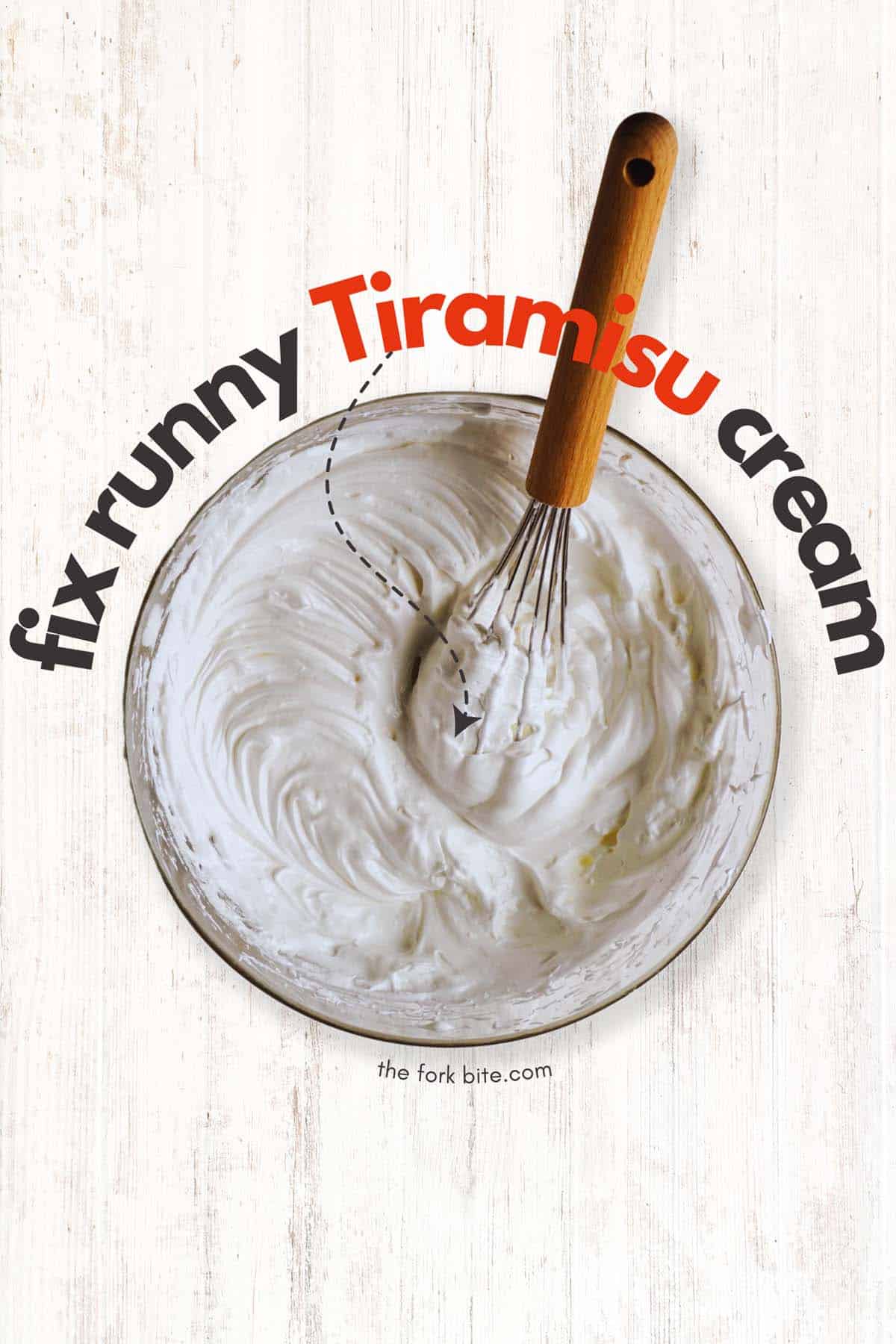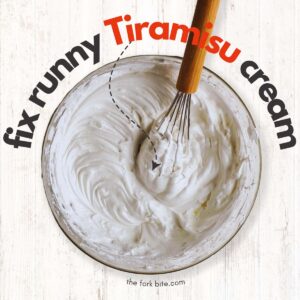Have you ever been caught in the dilemma of how to fix runny Tiramisu cream? We've all been there. One moment you're anticipating a velvety, rich cream, and the next, you're staring at a bowl of runny disappointment.
Quick Answer: To fix runny Tiramisu cream, ensure you whisk egg yolks and sugar until thick, then whip the cream to stiff peaks gradually. Combine with room-temperature Mascarpone, but don't overmix to avoid curdling. If the cream is still runny, chill it in the refrigerator to help it firm up.
But don't fret because, in this blog post, we will solve this creamy conundrum together. Using the wisdom from my baking adventures, let me guide you through some reliable methods to remedy your Tiramisu cream that is too runny and transform it into the creamy, cloud-like delight it's supposed to be.
Takeaways:
- Quality Ingredients Matter: It's crucial to use high-quality ingredients. Choose full-fat heavy cream and fresh mascarpone cheese, as they form the base for a stable and delicious Tiramisu cream.
- Temperature is Key: Maintain your ingredients at the right temperature. Whipping cream whips better when it's cold, and a cool environment helps achieve firm consistency.
- Perfect the Art of Mixing: Whip the cream to soft peaks and gently fold it into the mascarpone mixture. Overbeating can lead to a grainy or buttery texture, resulting in a runny cream.
Jump to:
The Tiramisu cream challenge
A culinary hiccup can bring even the most seasoned home bakers to their knees. If you're anything like me, you've spent countless hours in the kitchen, recipe book in hand, whisk at the ready, determined to whip up the perfect Tiramisu. But despite the best-laid plans, we've all been there—facing the dreaded runny Tiramisu cream.
Cream consistency
But why does the consistency matter so much? Well, I'll tell you. The creamy layer in our beloved Tiramisu isn't just filler—it's the heart and soul of the dessert. It's what gives Tiramisu its signature texture and rich, indulgent flavor. If it's too runny, it soaks into the ladyfingers too much, making everything a soggy mess.

Common mistakes leading to runny Tiramisu cream
1 Inaccurate measurement of ingredients
The road to runny cream often starts with a simple misstep - inaccurate measurements. Add too much heavy cream or Mascarpone, and you'll end up with a soupy mix. Not enough, and your cream lacks that rich, voluptuous texture. So, get friendly with your measuring cups and spoons – they're your secret weapon in the fight against runny Tiramisu cream! As I've found in my many kitchen escapades, precision is key in baking.
2 Wrong mixing techniques
Another pitfall on the path to perfect Tiramisu cream? The way we mix our ingredients. There's an art to it, you see. Whip the cream too little, and you won't have enough air bubbles for the right texture. But go too far, and you break down the fat network, leading to overwhipped cream that's likely to run. The key is to whip until you have soft peaks – they'll hold their shape without drooping.
3 Inappropriate ingredients' temperature
The temperature of your ingredients can make or break your Tiramisu cream. If your Mascarpone and heavy cream are too warm, they won't whip up properly, leaving you with a runny mess. Likewise, too cold, and the fat in the cream can seize up and curdle. It's a delicate balance. The sweet spot? Keep everything chilled, but not straight from the fridge.
4 Missteps in the egg yolk and sugar mixture
Finally, let's chat about those egg yolks. Mixed with sugar, they form the base of our Tiramisu cream. But this is a step where things can go awry. Overcook the yolk-sugar mix, and you'll scramble the eggs, leading to lumps. Undercook and you won't thicken the cream enough. The goal? Gentle heat until the mix coats the back of a spoon. Remember, patience is key!
How to identify a runny cream
Texture and color cues
Runny Tiramisu cream is easy to spot if you know what to look for. The perfect Tiramisu cream has a light, creamy color - not too white or yellow. If your cream looks a bit pale, that could be a sign that it's too runny.
Texture-wise, it should hold its own and not slump or spread out too easily. If you see your cream struggling to stand tall, you might have a runny situation!
Consistency and thickness
The true test of cream, though, is in the touch. When you lift your whisk, the cream should cling to it, forming soft peaks that hold their shape without drooping. If the cream slips right off or doesn't form peaks, that's a surefire sign it's too runny.
Likewise, it's too thin if you scoop up some cream, and it flows rather than holds its shape. Remember, we're after a luxuriously thick, light, and airy cream - the hallmark of a perfect Tiramisu cream!
Troubleshooting runny Tiramisu cream
When faced with runny Tiramisu cream, don't despair! Here's a step-by-step guide to bringing it back from the brink:
Start by placing your runny cream in the fridge. This helps to cool it down and firm it up a bit before you start your salvage operation.
Add more Mascarpone. This cheese is your cream's best friend. If you suspect you've added too much heavy cream, a bit more Mascarpone can help to balance it out. Stir it in gently until well combined. The added fat will help to thicken things up.
Try re-whipping your cream. Remember, you're after soft peaks - whip until you reach that point, then stop to avoid over-beating.
If all else fails, consider adding a touch of dissolved gelatin. A bit of dissolved unflavored gelatin can give your cream some much-needed stability. Mix a teaspoon of gelatin with a few tablespoons of hot water until dissolved, let it cool a bit, then gently fold it into your cream. Once it chills in the fridge, it'll help firm things up.
Give it time. Tiramisu cream can often thicken up nicely with a little patience and some chill time in the fridge. This helps all the ingredients meld together and allows the cream to firm up.
Patience is key. Tiramisu is a dish that likes to take its time. You might be surprised at how much it firms up with a bit of patience! Allow your dessert to rest in the refrigerator overnight.
Adjustments and additions: Thickening tips
If your cream is still too runny, it's time to adjust. Consider folding in some whipped egg whites for extra volume and stability. Remember to gently incorporate any additions to keep your cream light and airy. A delicate touch and a bit of patience can go a long way when it comes to Tiramisu cream.
Preventing runny Tiramisu cream
1 Choosing the right ingredients
Choosing the right ingredients is half the battle won. You want a creamy and rich brand for your Mascarpone but not too loose. A higher fat content often means a firmer cheese, which is what you want for your cream. The same goes for your heavy cream - go for one that's high in fat and doesn't contain any added sugars or stabilizers.
2 Proper storage of ingredients
Proper storage of your ingredients can make all the difference. Mascarpone and heavy cream should be chilled in the fridge until you're ready to use them. Cold ingredients will whip up better and give you a thicker, more stable cream.
3 Following accurate measurements
When it comes to creating the perfect Tiramisu cream, accuracy is everything. Measure your ingredients carefully to ensure you balance fats and liquids correctly. A little too much of one thing can throw the whole mixture off, leading to runny cream.
4 Correct whipping techniques
Perfect Tiramisu cream is all about the whip. Over-whipping can cause your cream to become too loose while under-whipping won't incorporate enough air for that light, fluffy texture you're after. Aim for medium peaks that hold their shape but still have a bit of a droop at the tip. And remember, it's easier to whip a little more if you need to than to undo over-whipping, so keep a close eye on your cream as it whips.
A step-by-step guide to perfect Tiramisu cream
Ingredients
- 6 large egg yolks (at room temperature)
- 1 cup superfine or caster sugar
- 1¾ cup heavy whipping cream (nicely chilled)
- ½ teaspoon pure vanilla extract
- 10 oz (1¼ cup) BelGioioso mascarpone cheese (at room temperature)
Instructions
Sabayon making: Heat and whisk. Alright, we're all set to craft the Sabayon. Start by heating an inch of water in a small pot and bring it to a boil. Dial the heat down to simmer. Find a bowl that fits snugly on top of the pot without dipping into the water.
Sabayon craft: Whisking the magic Pour the egg yolks and sugar into the bowl and give them a brisk mix. Plop the bowl onto the pot with simmering water. With a whisk in hand, keep stirring the egg and sugar blend for a good 10 minutes.
Note: This is the crux of Sabayon-making, you're basically cooking the eggs here. The result? A beautifully expanded and thickened Sabayon (also known as Zabaione).
Take off the heat. Once you're done with the whisking, take the bowl off the heat and continue whipping the yolks to cool them down. The end product should be thick with a lovely lemony-yellow hue. Allow it to cool before introducing Mascarpone.
A couple of Notes:
- If the bowl starts to feel too hot, raise it off the pot for about 15 seconds while you persist with the whisking. You can repeat this as many times as necessary.
- If you've used regular sugar instead of superfine or castor sugar, your Sabayon might turn out grainy. No worries there; the grains will dissolve as your Tiramisu firms up.
Mascarpone mix: Blend it right. Time to mix the room-temperature Mascarpone + the vanilla extract (optional) with the whipped yolks. Make sure you combine them well but don't go overboard with the mixing. You want to avoid any curdling happening here. Note: The Mascarpone needs about 15-20 minutes of sitting out. Don't let it warm up.
Whip the cream. Next, in a separate bowl, gently whip the cream to stiff peaks using an electric mixer. Kick things off at a low speed, gradually cranking it up over about ten minutes.
Why so meticulous? This slow and steady process ensures your whipped cream doesn't break. Be sure to use the freshest, ice-cold heavy cream you can find. The fresher, the better - just check the expiration date.
Tiramisu Assembly: The Final Fold. You're almost there! Now, delicately fold the whipped cream into the mascarpone sabayon mixture and pop it into the fridge. It can chill there until you're all set to assemble the Tiramisu.
Understanding the ingredients of Tiramisu cream
Mascarpone magic: The Italian heart of Tiramisu
I've got a lot of love for Mascarpone cheese. Born and bred in Italy, this creamy delight sits at the heart of every authentic Tiramisu. A buttery texture and mild, sweet taste bring a richness that's hard to match. Its creaminess is key for our Tiramisu - but remember, it's got to stay firm.
Heavy cream: The backbone of tiramisu
Heavy cream - it's the unsung hero in our Tiramisu saga. High in fat content (at least 36%), it whips up wonderfully, bringing body and structure to our cream mix. It lends a smooth, luxurious feel that makes every bite of Tiramisu a dream.
Sugar: The sweet balancer
Sugar, sweet sugar. It's not just there to satisfy our sweet tooth - it's crucial to achieving the right creamy consistency. But, like any good thing, balance is key. Too much sugar and our cream become a sweet soup. Just the right amount gives us that melt-in-your-mouth sensation.
Egg yolks: Nature's little emulsifier
Egg yolks. With their bright, sunshiny color, they do much more than add a beautiful hue to our cream. They're nature's emulsifier, binding the Mascarpone and cream into a velvety-smooth mix. As the yolks cook, they thicken our cream, creating that perfect, spoonable texture we crave in Tiramisu.
The science behind perfect Tiramisu cream
When it comes to whipping cream, it's all about chemistry, and the key player here is fat. The cream is an emulsion of fat droplets suspended in water, with a dash of proteins and milk sugars thrown in for good measure.
Whipping heavy cream is the opening act. As the whisk hits the cream, we're driving air into it. This process is known as aeration. Each tiny bubble of air gets coated with fat droplets, and as we continue to whip, these droplets start holding hands, forming a stable network. The result? A glorious, fluffy texture.
Next comes the emulsion. An emulsion is a stable blend of things that wouldn't ordinarily mix - like the oil in our egg yolks and the water in our mascarpone cheese and cream. This is where the magic of the egg yolks shines. They contain a natural emulsifier called lecithin, which helps the water and oil in our mix stay friendly, leading to a smooth, unified cream.
The final flourish comes when we gently heat our mixture. The heat coagulates the proteins in the yolks, thickening the cream and creating that rich, luscious texture we love. Every reaction and stage leads us to our dreamy, creamy goal. Understanding this process is your secret weapon to mastering the art of Tiramisu cream!
Note:
There's a fine line between perfection and disaster. Overwhipping breaks down the fat droplet network too much, causing the cream to separate into a buttery solid and a watery liquid.
The role of every ingredient
- Each ingredient in our Tiramisu cream is a star player in this culinary team. The Mascarpone cheese brings its signature richness and a solid foundation.
- The heavy cream, when whipped, adds volume and a luxuriously smooth texture.
- Sugar sweetens the deal (quite literally) while keeping the structure of our cream stable.
- And those yolks? They're the tie that binds, thickening the cream as they cook.
These ingredients work harmoniously to create that unmistakable Tiramisu cream we all love.
Ingredients: Selection and preparation
Choosing Mascarpone and heavy cream
The first step to a heavenly Tiramisu cream is picking the best Mascarpone and heavy cream. Now, Mascarpone should be fresh with a slight tang to its taste and a smooth, creamy texture. Avoid any that look grainy or separated - that's a sign it's past its prime.
For the heavy cream, freshness is key. Check the expiration date and ensure it has a clean, slightly sweet taste and a smooth texture. Remember, you're after cream with a high-fat content of at least 36%, so it whips up nicely and is fluffy.
Storage and preparation:
Once you've selected the best Mascarpone and heavy cream, it's time to treat them right. Both should be stored in the coldest part of your fridge - not in the door. Before using them, remove them from the refrigerator to knock off the chill, but make sure they're still cold when you whip them.
As for the eggs, keep them refrigerated but take them out about 30 minutes before you need them to bring them up to room temperature. This will make the yolks more pliable and easy to mix with the sugar.
Beyond Repair: When to start over
Recognizing unsalvageable cream
Even for seasoned bakers, there are times when a batch doesn't go as planned. It might be beyond saving if your cream has separated, turned grainy, or curdled. Over-whipping can also lead to a runny cream that won't hold its shape no matter what you add. In these cases, it might be time to start fresh. It's a tough call to make but remember - even the best of us have been there.
Learning from baking blunders
I'd be lying if I said I've never had a kitchen disaster or two. But here's the thing - every failed batch is a chance to learn something new. Maybe you learn that a certain brand of Mascarpone doesn't work well for your Tiramisu or that your hand mixer's lowest setting is still too fast for a gentle whip. And hey, even runny Tiramisu cream is still pretty delicious! Take these lessons to heart; your next batch will surely be a step up.
Prevention strategies: Ensuring a perfect cream next time
1 Accurate measurement
Always measure your ingredients precisely. I can't stress enough how important this is. Baking is a science, and every ingredient has its role to play. Going overboard with liquids or skimping the solids could easily lead to a runny cream.
2 Use fresh, high-quality ingredients
Opt for fresh and high-quality ingredients, especially when it comes to the mascarpone cheese and heavy cream. The better the quality, the better your cream will turn out.
3 Keep your cream chilled
Keep your cream as cool as possible. A cooler environment helps the cream whip better and stay firm. If your kitchen is warm, pop your mixing bowl and beaters in the fridge for a bit before you start.
Tips for incorporating consistent results
1 Slow and Steady: Gentle Mixing
Avoid over-mixing. Be gentle when folding your whipped cream into the Mascarpone and egg mixture. The aim is to keep that air in the cream, not knock it out!
2 Cold Truth: Refrigerate Before Serving
Allow your Tiramisu to set in the fridge before serving. This gives the cream time to firm up and hold its shape.
3 Practice Makes Perfect: Keep Trying
Don't get disheartened if your cream doesn't come out perfect the first time. Like any skill, making the ideal Tiramisu cream takes practice. The more you do it, the better you'll understand the nuances leading to a perfect cream.
Frequently Asked Questions
Runny Tiramisu cream can be due to several reasons, such as overbeating, warm ingredients, or inaccurate measurements. The quality of ingredients also plays a key role.
To fix a runny Tiramisu cream, you could try adding more mascarpone cheese or whipping cream, but be careful not to overbeat. Also, chilling the mixture might help it firm up.
While low-fat cream is healthier, it may not give you the firm consistency needed for Tiramisu. Full-fat heavy cream is usually the best option.
The time can vary, but usually, it takes about 4-5 minutes to whip the cream to soft peaks. Be careful not to overwhip, as it can cause the cream to become grainy or buttery.
Start by beating the egg yolks and sugar until creamy and pale, then add the mascarpone cheese. Whip the heavy cream to soft peaks in a separate bowl, then gently fold it into the mascarpone mixture.
If the Tiramisu cream is too runny and can't be fixed, it might be best to start over. Measure your ingredients accurately and ensure they are at the right temperature.
Prevention strategies include accurate measurements, high-quality fresh ingredients, ensuring a cool environment while whipping cream, and gentle mixing.
Quality mascarpone is crucial for a stable Tiramisu cream. Lower-quality cheese can have a higher water content, leading to a runny cream.
Cold ingredients, especially the heavy cream, whip better and create a firmer cream. Warmer ingredients can cause the cream to be runnier.
Yes, even if it's not as firm as it should be, runny Tiramisu cream can still taste delicious. However, you'd want a firmer cream for the best texture and presentation.
How to Fix Runny Tiramisu Cream
Pin RecipeInstructions:
- Start by placing your runny cream in the fridge. This helps to cool it down and firm it up a bit before you start your salvage operation.
- Add more Mascarpone. This cheese is your cream's best friend. If you suspect you've added too much heavy cream, a bit more Mascarpone can help to balance it out. Stir it in gently until well combined. The added fat will help to thicken things up.
- Try re-whipping your cream. Remember, you're after soft peaks - whip until you reach that point, then stop to avoid over-beating.
- If all else fails, consider adding a touch of dissolved gelatin. A bit of dissolved unflavored gelatin can give your cream some much-needed stability. Mix a teaspoon of gelatin with a few tablespoons of hot water until dissolved, let it cool a bit, then gently fold it into your cream. Once it chills in the fridge, it'll help firm things up.
- Give it time. Tiramisu cream can often thicken up nicely with a little patience and some chill time in the fridge. This helps all the ingredients meld together and allows the cream to firm up.
- Patience is key. Tiramisu is a dish that likes to take its time. You might be surprised at how much it firms up with a bit of patience! Allow your dessert to rest in the refrigerator overnight.
Notes:
Common mistakes leading to runny tiramisu cream:
1 inaccurate measurement of ingredients
The road to runny cream often starts with a simple misstep - inaccurate measurements. Add too much heavy cream or Mascarpone, and you'll end up with a soupy mix. Not enough, and your cream lacks that rich, voluptuous texture. So, get friendly with your measuring cups and spoons – they're your secret weapon in the fight against runny Tiramisu cream! As I've found in my many kitchen escapades, precision is key in baking.2 wrong mixing techniques
Another pitfall on the path to perfect Tiramisu cream? The way we mix our ingredients. There's an art to it, you see. Whip the cream too little, and you won't have enough air bubbles for the right texture. But go too far, and you break down the fat network, leading to overwhipped cream that's likely to run. The key is to whip until you have soft peaks – they'll hold their shape without drooping.3 inappropriate ingredients' temperature
The temperature of your ingredients can make or break your Tiramisu cream. If your Mascarpone and heavy cream are too warm, they won't whip up properly, leaving you with a runny mess. Likewise, too cold, and the fat in the cream can seize up and curdle. It's a delicate balance. The sweet spot? Keep everything chilled, but not straight from the fridge.4 missteps in the egg yolk and sugar mixture
Finally, let's chat about those egg yolks. Mixed with sugar, they form the base of our Tiramisu cream. But this is a step where things can go awry. Overcook the yolk-sugar mix, and you'll scramble the eggs, leading to lumps. Undercook and you won't thicken the cream enough. The goal? Gentle heat until the mix coats the back of a spoon. Remember, patience is key!how to identify a runny cream:
texture and color cues
Runny Tiramisu cream is easy to spot if you know what to look for. The perfect Tiramisu cream has a light, creamy color - not too white or yellow. If your cream looks a bit pale, that could be a sign that it's too runny. Texture-wise, it should hold its own and not slump or spread out too easily. If you see your cream struggling to stand tall, you might have a runny situation!consistency and thickness
The true test of cream, though, is in the touch. When you lift your whisk, the cream should cling to it, forming soft peaks that hold their shape without drooping. If the cream slips right off or doesn't form peaks, that's a surefire sign it's too runny. Likewise, it's too thin if you scoop up some cream, and it flows rather than holds its shape. Remember, we're after a luxuriously thick, light, and airy cream - the hallmark of a perfect Tiramisu cream!Please note that all nutrition information are just estimates. Values will vary among brands, so we encourage you to calculate these on your own for most accurate results.





